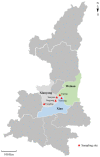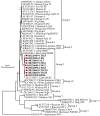Molecular Characterization of Cryptosporidium spp., Giardia duodenalis, Enterocytozoon bieneusi and Escherichia coli in Dairy Goat Kids with Diarrhea in Partial Regions of Shaanxi Province, China
- PMID: 37760322
- PMCID: PMC10526037
- DOI: 10.3390/ani13182922
Molecular Characterization of Cryptosporidium spp., Giardia duodenalis, Enterocytozoon bieneusi and Escherichia coli in Dairy Goat Kids with Diarrhea in Partial Regions of Shaanxi Province, China
Abstract
Cryptosporidium spp., Giardia duodenalis, Enterocytozoon bieneusi and Escherichia coli are important diarrheal pathogens threatening the health of humans and various animals. Goats, especially pre-weaned goat kids, that carry these pathogens are important reservoirs related to human infection. In the present study, PCR-based sequencing techniques were applied to characterize Cryptosporidium spp., G. duodenalis, E. bieneusi and E. coli in 202 fecal samples of diarrheal kids for Guanzhong dairy goats from five locations in Shaanxi Province. The positive rates of Cryptosporidium spp., G. duodenalis, E. bieneusi and E. coli were 37.6% (76/202), 16.3% (33/202), 55.4% (112/202) and 78.7% (159/202) in these goat kids, respectively. Co-infection of two to four pathogens was found in 114 of 202 fecal samples. Significant differences (p < 0.001) in the positive rates of Cryptosporidium spp. and G. duodenalis were found among locations and age groups. Furthermore, two Cryptosporidium species (C. parvum and C. xiaoi), two G. duodenalis assemblages (E and A), nine E. bieneusi genotypes (CHG3, CHG1, BEB6, CHG5, CHG2, SX1, CHG28, COS-II and CD6) and two E. coli pathotypes (EPEC and EHEC) were identified. As for Cryptosporidium, two (IIdA19G1 and IIdA19G2) and two (XXIIIa and XXIIIg) subtypes were recognized in samples positive for C. parvum and C. xiaoi, respectively. A phylogenetic analysis based on the ITS locus of E. bieneusi indicated that all nine genotypes of E. bieneusi identified in this study belonged to the group 2. Four virulence factors (ehxA, eae, stx2 and stx1) of EPEC and EHEC were found in E. coli strains. Collectively, this study explored the colonization frequency of Cryptosporidium spp., G. duodenalis, E. bieneusi and E. coli in diarrheal kids of Guanzhong dairy goats in Shaanxi Province and expanded our understanding of the genetic composition and zoonotic potential of these pathogens in goats.
Keywords: Cryptosporidium spp.; Enterocytozoon bieneusi; Escherichia coli; Giardia duodenalis; Shaanxi; goat.
Conflict of interest statement
The authors declare no conflict of interest.
Figures





Similar articles
-
Infection rate of Giardia duodenalis, Cryptosporidium spp. and Enterocytozoon bieneusi in cashmere, dairy and meat goats in China.Infect Genet Evol. 2016 Jul;41:26-31. doi: 10.1016/j.meegid.2016.03.021. Epub 2016 Mar 25. Infect Genet Evol. 2016. PMID: 27017915
-
Genotyping of Cryptosporidium spp., Giardia duodenalis and Enterocytozoon bieneusi from sheep and goats in China.BMC Vet Res. 2022 Sep 29;18(1):361. doi: 10.1186/s12917-022-03447-6. BMC Vet Res. 2022. PMID: 36175887 Free PMC article.
-
Prevalence and genotypic identification of Cryptosporidium spp., Giardia duodenalis and Enterocytozoon bieneusi in pre-weaned dairy calves in Guangdong, China.Parasit Vectors. 2019 Jan 17;12(1):41. doi: 10.1186/s13071-019-3310-5. Parasit Vectors. 2019. PMID: 30654832 Free PMC article.
-
A review of the molecular epidemiology of Cryptosporidium spp. and Giardia duodenalis in the Middle East and North Africa (MENA) region.Infect Genet Evol. 2022 Mar;98:105212. doi: 10.1016/j.meegid.2022.105212. Epub 2022 Jan 20. Infect Genet Evol. 2022. PMID: 35065302 Review.
-
Molecular epidemiologic tools for waterborne pathogens Cryptosporidium spp. and Giardia duodenalis.Food Waterborne Parasitol. 2017 Sep 29;8-9:14-32. doi: 10.1016/j.fawpar.2017.09.002. eCollection 2017 Sep-Dec. Food Waterborne Parasitol. 2017. PMID: 32095639 Free PMC article. Review.
Cited by
-
Global prevalence of Giardia infection in nonhuman mammalian hosts: A systematic review and meta-analysis of five million animals.PLoS Negl Trop Dis. 2025 Apr 24;19(4):e0013021. doi: 10.1371/journal.pntd.0013021. eCollection 2025 Apr. PLoS Negl Trop Dis. 2025. PMID: 40273200 Free PMC article.
-
Prevalence and Molecular Characterization of Cryptosporidium spp., Giardia duodenalis, and Enterocytozoon bieneusi in Cattle in Heilongjiang Province, Northeast China.Animals (Basel). 2024 May 30;14(11):1635. doi: 10.3390/ani14111635. Animals (Basel). 2024. PMID: 38891682 Free PMC article.
-
Molecular prevalence and genotype identification of Enterocytozoon bieneusi in cattle and goats from Zhejiang Province, China.Front Vet Sci. 2024 Nov 19;11:1415813. doi: 10.3389/fvets.2024.1415813. eCollection 2024. Front Vet Sci. 2024. PMID: 39628867 Free PMC article.
-
Prevalence and Genetic Characterization of Giardia duodenalis and Blastocystis spp. in Black Goats in Shanxi Province, North China: From a Public Health Perspective.Animals (Basel). 2024 Jun 17;14(12):1808. doi: 10.3390/ani14121808. Animals (Basel). 2024. PMID: 38929427 Free PMC article.
References
-
- Zhu G., Yin J., Cuny G.D. Current status and challenges in drug discovery against the globally important zoonotic cryptosporidiosis. Anim. Dis. 2021;1:3. doi: 10.1186/s44149-021-00002-y. - DOI
Grants and funding
LinkOut - more resources
Full Text Sources
Research Materials
Miscellaneous

